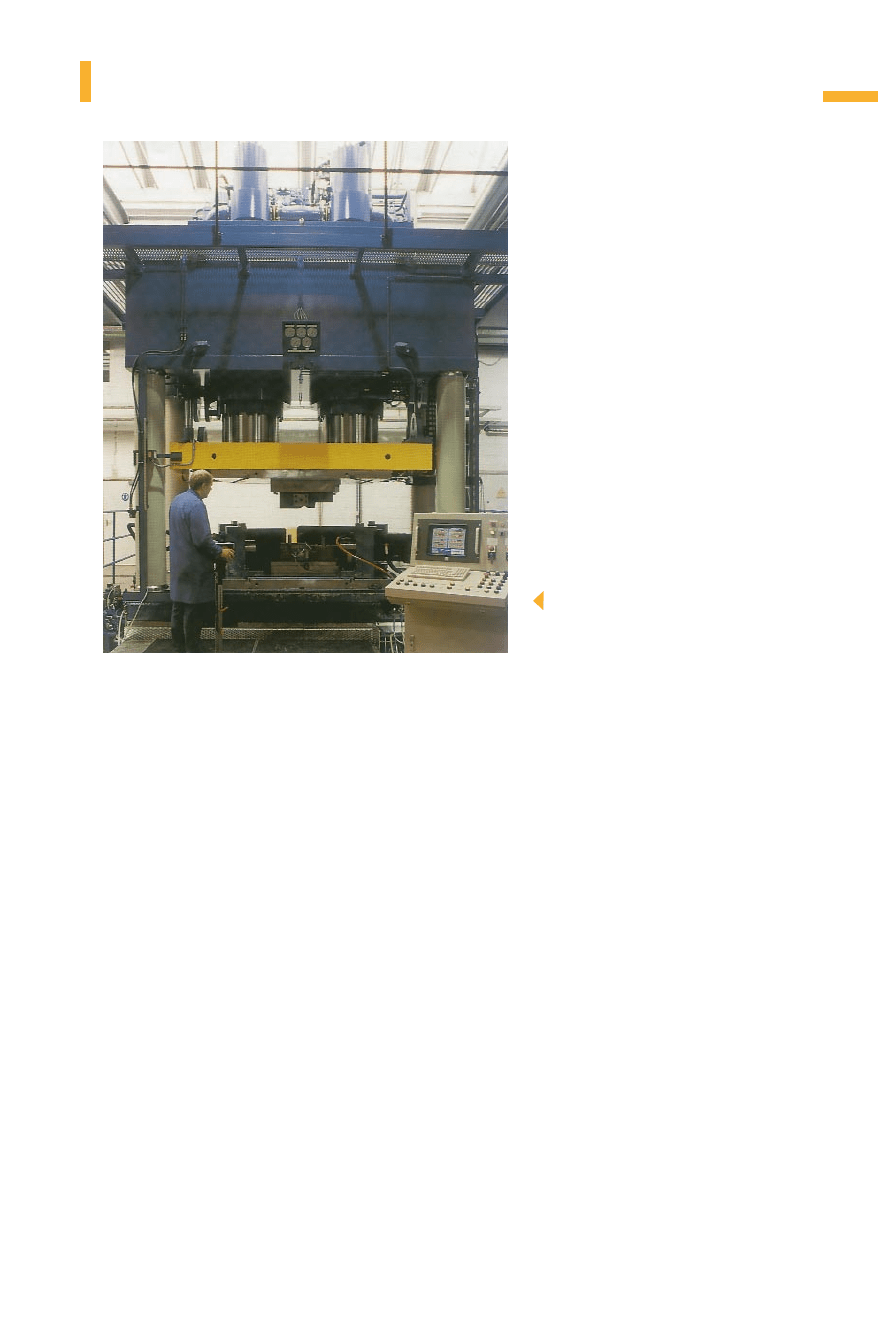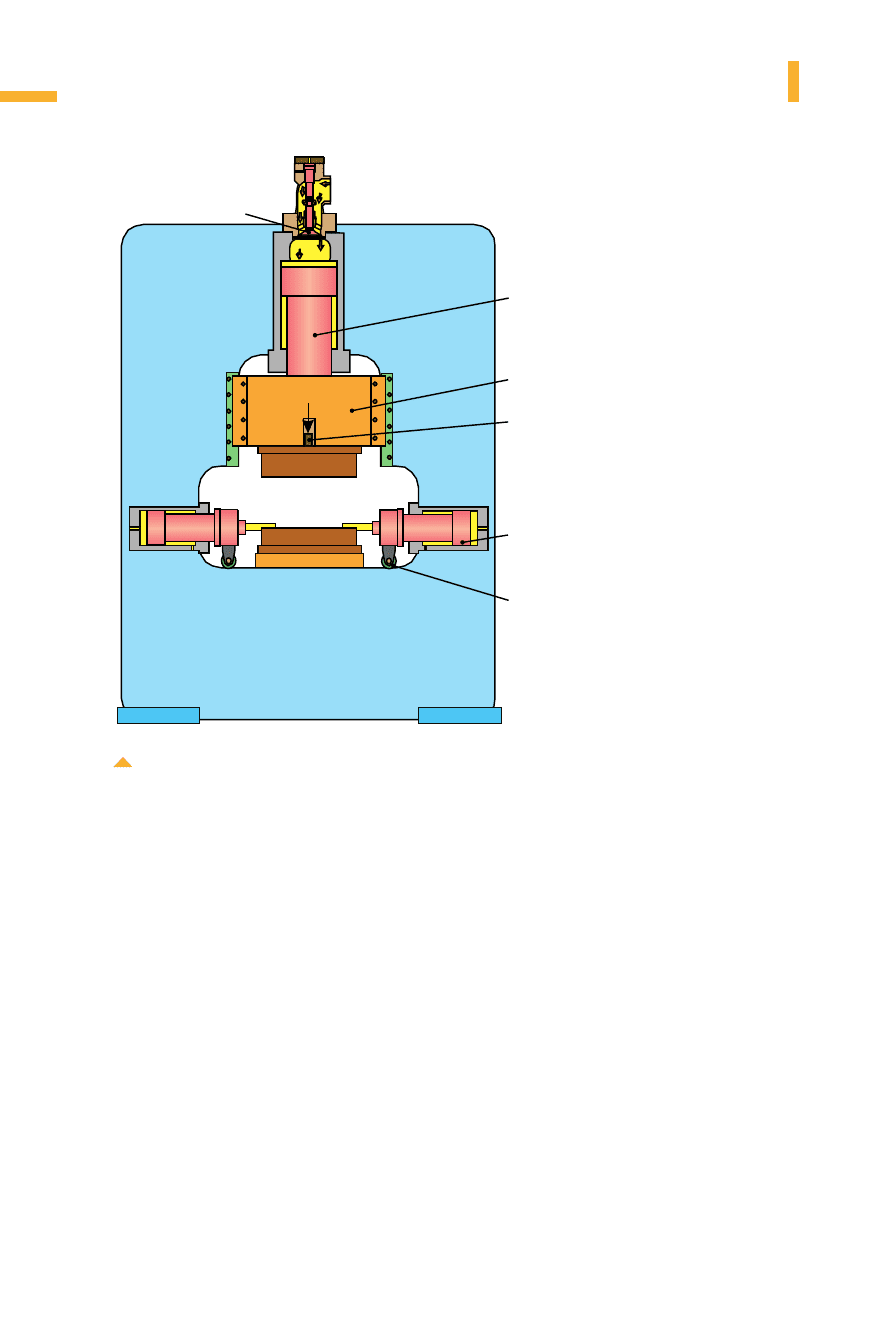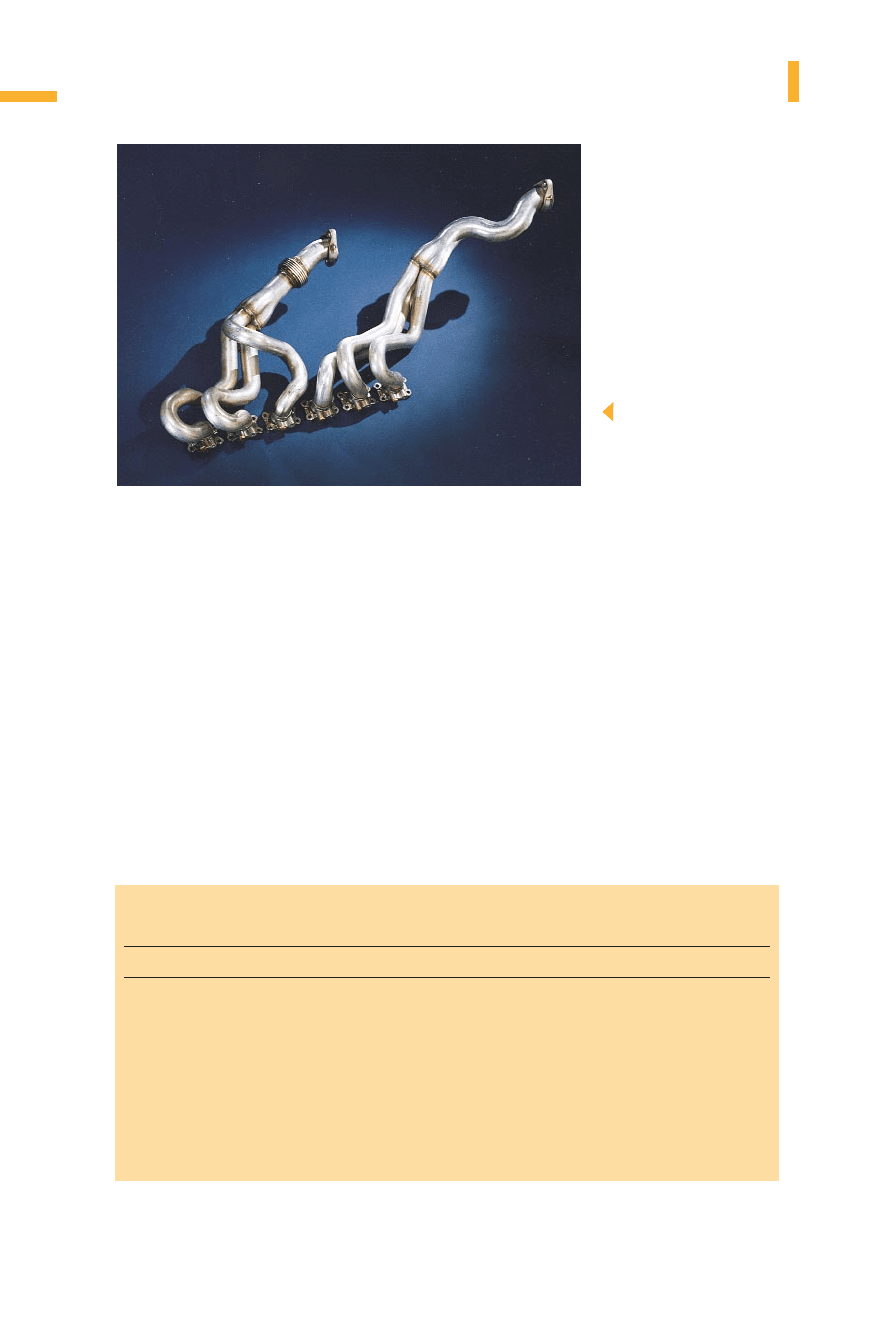Altan T. Metal Forming Handbook
Подождите немного. Документ загружается.


diameter and stroke are adjusted to the specific requirements of the
component. The cylinder holder brackets absorb the axial forces and
align the horizontal cylinders concentrically with the end guides. These
can be moved and positioned on the bed or slide plate.
The modular basic structure of the dies permits flexible implementa-
tion of the required component geometries. The objective is to mini-
mize production costs, die changing times and the time required to
exchange worn parts. In addition, during the development phase it is
possible to try out different tube materials and wall thicknesses without
changing the dies. Thus, it is possible to test various preform geometries
with a minimum of trouble and expense.
Simple changeover from prototype dies to production dies is possible
if only cavity or sliding inserts have to be exchanged (Fig. 5.4.2).When
designing a prototype die, its service life is only of minor importance.
Except for the sliding inserts, it is not necessary to have time-consum-
ing coatings or other surface treatments of the die inserts. Prototyping
– and thus step-by-step progress towards a die suitable for series pro-
duction – takes place in several stages:
421
Die engineering
Fig. 5.4.2 Die systems for prototyping and production
prototypedie productiondie
exchangeofwearingparts
modificationofindividualcontoursections
workpiece basicdie horizontalcylinder diecavityinsert
counterpressure
punch
slidinginsert
Metal Forming Handbook / Schuler (c) Springer-Verlag Berlin Heidelberg 1998

–development of the basic component geometry,
–integration of supplementary operations such as hole piercing,
–production of modified inserts.
Here, the following parameters influence the selection of tool materials
and the necessary coating or treatment:
–component geometry,
–component material,
–maximum internal pressure,
–sealing system,
–application (prototyping, series operation).
5.4.2Lubricants
As is the case in other cold forming operations, lubricants are among
the most important aids in the hydroforming process, as they minimize
friction at locations with relative motion between die and workpiece
(cf. Sect. 4.2.3). Many components can only be manufactured in the
required shape only through the use of appropriate lubricants.
Lubricants permit to obtain more even wall thickness variation, sim-
plify the forming of tubular branches, reduce partial stretching process-
es and improve forming in areas that do not allow any material flow by
axial feed.
A number of different lubricants can be considered for use in hydro-
forming. Depending on their composition, these can be assigned to the
following groups:
–solid lubricants, generally on a graphite or MoS
2
basis,
–polymer dispersion-based lubricants,
–waxes, oils and
–emulsions.
Lubricant is generally applied by means of spraying or immersion.
Except in the case of oils, the applied coating must generally have dried
and hardened prior to the forming process. On principle, attention
must be paid to ensure an even coating thickness. The optimum thick-
ness of the lubricant layer must be determined by trial and error.
422
Hydroforming
Metal Forming Handbook / Schuler (c) Springer-Verlag Berlin Heidelberg 1998

5Hydroforming
5.5Materials and preforms for
producing hydroformed components
5.5.1Materials and heat treatment
Basically the same materials which can be used for other cold form-
ing techniques such as deep-drawing (cf.Table4.2.3) are suitable for
hydroforming applications. The material should have a fine-grained
microstructure and be soft-annealed.
The best forming results are achieved using materials with a high
degree of ultimate elongation, whereby the ultimate elongation at right
angles to the longitudinal direction of the tube – i.e. generally at right
angles to the rolling direction of the sheet metal – is important for the
configuration of hydroform components. A high degree of strain hard-
ening is beneficial.
The tube manufacturing process and pre-forming bring about a
strain hardening effect which may have to be eliminated by annealing
for certain components prior to the hydroforming process. If the forma-
bility of the material is exceeded during a production step in the man-
ufacturing process, forming must be performed using several stages
(progressive forming) with intermediate annealing. However, due to
the additional costs involved, heat treatment should only be carried
out when all other possibilities, for example design or material modifi-
cations, have been exhausted.
The preferable method of heat treatment for austeniticsteels is solu-
tionizing – ideally using inert gas. For small parts, a continuous furnace
can be used.
Metal Forming Handbook / Schuler (c) Springer-Verlag Berlin Heidelberg 1998

In the case of ferriticsteel, the type and practicality of heat treatment
depend heavily on the respective material and its forming history. On
principle, either of two possible processes can be used: recrystallization
and normal annealing.
Generally, Mn or Si alloys are used for aluminium.The most favorable
method of heat treatment must be determined in each individual case,
whereby particular attention must be paid to the long-term behavior of
the material, and in the case of strain hardening alloys, to rapid further
processing.
5.5.2Preforms and preparation
For hydroforming, parts made of the following semi-finished products
are used (Fig. 5.2.8):
–drawn or welded tubes,
–double-walled tubes,
–extruded profiles,
–welded or pre-formed tubular blanks.
In general, tubular preforms with circular cross sections are used.
Welded and extruded non-round sections are used less frequently.
The production steps required for the preparation of preforms for
technically and economically optimum production are described in the
following with reference to tubular blanks.
The tubecuttingprocess must be extremely precise in order to avoid
undesirable effects such as leaks at the beginning of the hydroforming
sequence. These would lead to failure of the component as a result of
buckling. Fluctuations in the wall thickness along the periphery result
in a high scrap level, and in extreme cases even to failure of the com-
ponent. The following tolerances are generally admissible:
–length: +/– 0.5 mm
–angle of the cross section relative to the longitudinal axis: +/– 0.5°
Concentricity at the tube ends is important in order to avoid unwanted
shearing when the die is closed. The tubes must be cleaned of any
chips, as these lead to tool damage, forming errors or marks on the sur-
424
Hydroforming
Metal Forming Handbook / Schuler (c) Springer-Verlag Berlin Heidelberg 1998

face of the component. Tube ends must be deburred for the same rea-
son, although chamfers must be avoided under any circumstances.
The ideal preform for the hydroforming process is a straight cylindri-
cal tube. However, deviations from this shape are common, as the tube
must be laid adequately in the die in order to ensure part quality. This
necessitates a pre-formingprocess. On principle, any pre-forming process
reduces subsequent formability and leads to differences in the wall
thickness and faults in the forming behavior of the parts as a result of
local strain hardening. However, suitable configuration of the compo-
nent and optimum selection of the pre-forming process can counteract
these negative effects.
Bendingis performed on a mandrel, profile, cam or induction bend-
ing machine depending on the bending radius, tube diameter and wall
thickness (cf.Sect.4.8). Because of the notching effects that may oc-
cur, surface damage, in particular sharp-edged impressions created by
clamping jaws, may lead to premature bursting of the component. The
tolerance for the straight ends, as for cutting, is +/– 0.5 mm. Bending
errors, such as wrinkles on inside bends, impressions left by clamping
jaws or drawing grooves must be avoided, particularly in the case of
thin-walled tubular blanks.
Reduction and expansionprocesses are used where large peripheral dif-
ferences are required on long elongated components or in case of par-
tial oversize of the used tube in the central section. Here, too, process-
specific defects such as grooves, impressions etc. could have a detri-
mental effect.
Pre-forming in the hydroform dierepresents an ideal solution if it can
eliminate any other pre-forming steps required on the straight tube.
Pre-forming is also carried out on parts which have been previously
bent, expanded or reduced.
Pre-forming in the dieis used in the case of complex geometries, where
the above processes fail to produce satisfactory results.
Special processes also exist for tapered, welded tubes, welded tubes
with non-round sections, deep-drawn half shells, extruded sections and
joined tubes. In the case of complex components, several pre-forming
steps can be necessary.
425
Materials and preforms for producing hydroformed components
Metal Forming Handbook / Schuler (c) Springer-Verlag Berlin Heidelberg 1998

5Hydroforming
5.6Presses for hydroforming
Hydroforming presses are specially designed presses that have:
–the electronic system,
–the oil hydraulics,
–the pressure medium hydraulics and control system,
–the bed and slide
adapted to the special requirements of hydroforming. The press types used
are either four-upright presses (Fig.5.6.1) or frame presses (Fig. 5.6.2).The
four-upright construction guarantees optimum accessibility of dies for
loading, process control and die component changeover. The die can be
mounted outside the press and fed into the press using a die changing sys-
tem. Inside the press, the die is locked in position by hydraulic clamps: All
that is necessary to create the hydraulic and electrical connections. Die
change can be executed depending on requirements at the press location
on one of the four sides (cf. Sect. 3.4). The position of the horizontal cylin-
der is flexible.
Frame presses are used as single-purpose presses for the production of
fittings. The horizontal cylinders of this type of press are permanently
installed.
The closing force is applied by means of vertical plunger or differen-
tial cylinders (cf. Sect. 3.3). User-specific factors are taken as a basis for
–configuration of the plungers and differential cylinders,
–the stroke and diameter of the horizontal and counterpressure cylin-
ders,
–dimensioning the pressure intensifier and
–determining the size of the bed.
Metal Forming Handbook / Schuler (c) Springer-Verlag Berlin Heidelberg 1998

Controllable pumps fill the workpieces up to a defined initial pres-
sure with pressure medium. Pressure levels exceeding this are generated
by the pressure intensifier. The line control system is configured for at
least four controlled hydraulic axes – one pressure intensifier, two hor-
izontal cylinders and one counterpressure cylinder. All these axes can
be controlled to be displacement or pressure-dependent. The closing
process for coined bends is provided as the fifth axis. The number of
axes can be increased, for example if different components or compo-
nents with subsequent stroke have to be formed in a single press stroke.
All the necessary process data is entered at the host computer (cf.
Sect. 3.5). The sequence of the forming process is executed in the form
of a series of steps containing the data on various axes and any addi-
tional control commands. The pressure and position of all axes can be
monitored during execution of the process on-line on the screen. They
can also be recorded. The programmed data from the step chain can be
viewed at any time in the form of a diagram. It is possible to draw up a
427
Presses for hydroforming
Fig. 5.6.1
Four-upright hydroforming press
with a closing force of 25,000 kN
Metal Forming Handbook / Schuler (c) Springer-Verlag Berlin Heidelberg 1998

response plan which corrects certain errors automatically using the pre-
scribed measures where these occur.
Taking into account the necessary safety measures, the line can be
loaded either fully automatically or manually.
428
Hydroforming
Fig. 5.6.2 Frame-type hydroforming press
slide cylinder
slide
counterpressure
punch
horizontal cylinder
pressure beam with
support roll
filling valve
Metal Forming Handbook / Schuler (c) Springer-Verlag Berlin Heidelberg 1998

5Hydroforming
5.7General considerations
5.7.1Production technology issues
Any comparison between hydroforming and other processes – such as
compression moulding, assembly of stamped parts, casting or assembly
of bent tubes – must take into consideration all the technical as well as
economic aspects. Preceding and subsequent work steps and the prop-
erties of the finished component must also be included into any evalu-
ation. Production by means of hydroforming can, for instance, appear
uneconomical for small quantities if only the component costs are con-
sidered, as the cycle times required are relatively long (Table 5.7.1).
However, if we compare the technical properties of the end product
with those produced using different techniques, it is possible to make
up for this drawback. Where medium and high quantities of a compo-
nent suitable for hydroforming are involved, the technical and eco-
nomic benefits of hydroforming can be brought so effectively to bear
that no other manufacturing processes can realistically be considered.
Table 5.7.1: Cycle times for different parts
Component Automation Components per stroke Cycle time
exhaust manifold with dome no 2 15 ... 25 s
exhaust manifold tube yes 2 ... 4 15 ... 20 s
side member for pick-up yes 2 40 s
instrument panel rail yes 1 35 s
T-fittings yes up to 25 13 s
Metal Forming Handbook / Schuler (c) Springer-Verlag Berlin Heidelberg 1998

Figure 5.7.1and Table 5.7.2 compare a conventional with a hydroform-
ing construction of an exhaust manifold.
Further processing of parts
Further processing of hydroformed parts includes any production
processes which are executed directly on the component following the
hydroforming sequence or which are used to join hydroformed parts
together. If the geometry of the parts or specific requirements prevent
them from being pressed to their final dimension, finish processingis nec-
essary. The required final form is achieved using, for example, cutting,
stamping or milling processes.
430
Hydroforming
Fig. 5.7.1
Hydroforming exhaust
manifold:
series production
Photo Schmitz und Brill
Table 5.7.2: Comparison of conventional and hydroforming production for the exhaust manifold illus-
trated in Fig. 5.7.1
Conventional production Hydroforming production
number of individual parts 17 9
service life 700 – 1,000 h > 1,500 h
manufacturing costs 100 % 85 %
development time 100 % 33 %
flange type varies same
weight 100 % 100 %
scrap < 0.5 %
Metal Forming Handbook / Schuler (c) Springer-Verlag Berlin Heidelberg 1998
